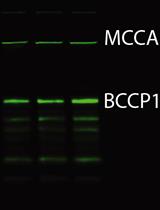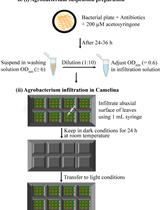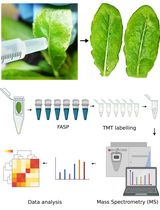- EN - English
- CN - 中文
Identification of S-locus F-box Protein Sequences in Diploid Potato, Solanum okadae, via Degenerate PCR
通过简并PCR鉴定二倍体马铃薯Solanum okadae中的S位点F-box蛋白序列
发布: 2025年06月05日第15卷第11期 DOI: 10.21769/BioProtoc.5328 浏览次数: 1925
评审: Jian You WangAnonymous reviewer(s)
Abstract
In many plant species, self-incompatibility (SI) is a mechanism that inhibits inbreeding. SI is gametophytic in the Solanaceae, with specificity determined by S-ribonucleases (S-RNases) in the pistil and S-locus F-box proteins (SLFs) in the pollen. The role of these proteins has been studied extensively in the Solanaceae, often using Petunia as a model. Using degenerate PCR and Sanger sequencing, this protocol identified three SLF sequences from self-incompatible diploid potato (Solanum okadae). While SLFs are well-characterized in model species like Petunia, there is limited sequence data and no standardized protocols for identifying SLFs in non-model species such as S. okadae, hindering broader insights into SI across the Solanaceae. This protocol fills that gap by using degenerate PCR and Sanger sequencing with primers designed from conserved Petunia SLF regions to identify SLF sequences in S. okadae. SLF sequences from 10 distinct Solanaceae members sharing maximum identity with the S2-haplotype of Petunia were used to design two pairs of primers targeting different regions of the target sequence. PCR amplification using designed degenerate primers yielded amplicons that were directly sequenced and joined together to get the partial SLF sequence. It was observed that the S. okadae shared an orthologous relation with the Petunia SLF according to the phylogenetic analysis. These SLFs could be used in future SI breakdown experiments via the competitive interaction route. This protocol, including the primer design, is novel for detecting SLF sequences in S. okadae.
Key features
• This protocol is applicable when the exact nucleotide sequence of the target DNA is not known but can be deduced from an amino acid sequence.
• Straightforward, cost-effective, and can be used to find “new” genes or gene families.
• Guidelines and a systematic approach for designing degenerate primers, along with a framework for annotating and comparing SLF genes within the Solanaceae family.
Keywords: Degenerate PCR (简并PCR)Background
Many plant species use self-incompatibility (SI) to prevent inbreeding. SI is governed by the polymorphic S-locus, which contains a single pistil-specific S-RNase gene along with a collection of pollen-specific S-locus F-box (SLF) genes. The developing pollen tube absorbs cytotoxic S-RNases from the pistil; however, only those S-RNases that correspond to the pollen's S-haplotype impede pollen tube growth. The collaborative non-self-recognition model [1] posits that each SLF protein functions as an E3 ubiquitin ligase subunit, facilitating the ubiquitination and subsequent degradation of its interacting non-self-S-RNase(s). The complete suite of SLF proteins must collaborate to detoxify all non-self-S-RNases, facilitating cross-compatible pollination and promoting outcrossing. The expression of an SLF from a different S-haplotype in pollen protects the pollen from its own S-RNase, thereby eliminating incompatibility, a process referred to as competitive interaction [2]. A previous study [3] found that Petunia S-RNases can be detoxified by SLFs from various taxa in 22 of 26 cases.
The identification of novel members of gene families through polymerase chain reaction (PCR) utilizing degenerate primers has often been perceived as more of an artistic endeavor than a scientific one. This perception has resulted in reluctance among researchers in creating methodologies that adequately tackle the essential factors related to experimental design, along with the lack of a detailed protocol for its implementation. Most applications of PCR rely on the precise design of primers that correspond to a designated target sequence. In the absence of adequate genome sequence data, degenerate consensus primers derived from reverse-translated sequences of highly conserved amino acid regions are commonly employed to isolate homologous sequences of specific gene family members in various organisms. Regions are generated through multiple amino acid alignments or synthesis of protein blocks primarily based on the sequences of distantly related species [4]. The present study employed a similar approach to identify three putative SLF sequences in S. okadae, which could be used to identify other SLFs in other Solanum species. These might be employed in future research to break down the SI by competitive interaction, an alternative to S-RNase knockout.
Materials and reagents
Biological materials
1. Seeds of Solanum okadae (accession: OKA 7129) obtained from The James Hutton Institute (Invergowrie, Scotland) were germinated and grown in a glasshouse environment at 22 °C ± 2 °C with a 16 h photoperiod. The following protocol uses young leaves from 2-week-old plants
Reagents
1. GenEluteTM Plant Genomic DNA Miniprep kit (Sigma-Aldrich, catalog number: G2N70-1KT)
2. MyTaq Extract-PCR kit (Bioline, catalog number: BIO-21126)
3. GeneJET Gel Extraction kit (Thermo Scientific, catalog number: K0691)
4. Agarose (Sigma-Aldrich, catalog number: A9539-500G)
5. UltraPureTM TBE buffer, 10× (Invitrogen, catalog number: 15581-044)
6. Ethidium bromide (EtBr) (Fisher Bioreagents, catalog number: BP1302-10)
7. DNA HyperLadder 1 kb (Bioline, catalog number: BIO-33053)
8. 5× DNA loading buffer blue (Bioline, catalog number: BIO-37045)
Solutions
1. 1× TBE buffer (working) (see Recipes)
2. 0.8% (w/v) agarose gel with EtBr (see Recipes)
Recipes
1. 1× TBE buffer (working)
Mix 100 mL of 10× UltraPureTM TBE buffer thoroughly with 900 mL of distilled water.
2. 0.8% (w/v) agarose gel with EtBr
Add 0.8 g of agarose per 100 mL of 1× TBE buffer and heat until agarose is dissolved. Let it cool for 5 min. Add 5 μL of EtBr just before pouring the gel in the electrophoresis tray on the lab bench.
Laboratory supplies
1. Pipette tips (10, 100, 1,000 μL) (Thermo Scientific)
2. 1.5 mL Eppendorf tubes (Sarstedt, catalog number: 72.690)
3. PCR 8-tube strips with individual attached caps (Greiner bio-one, catalog number: 608281)
Equipment
1. Electric water bath (Grant instruments Ltd., Cambridge, model: BAT3312)
2. Mortar and pestle (KPM, Berlin, catalog number: 39304000)
3. Analog vortex mixer (VWR International, catalog number: OHAU30392141)
4. Digital balance (A&D Company Limited, model: HF4000)
5. Centrifuge (Thermo Scientific, model: Pico 21)
6. Forceps (BochemTM Stainless Steel Sharp Tip Forceps, catalog number: 1133)
7. Scalpel (carbon steel surgical blade, Swann-Morton)
8. Automated thermal cycler (Applied Biosystems, model: GeneAmp 9700)
9. Spectrophotometer (NanoDrop Technologies, model: ND-1000 Spectrophotometer)
10. Gel casting tray & power pack (Bio-Rad, catalog number: 1640302)
11. UV transilluminator crosslinkers (Syngene, catalog number: 12874028)
Software and datasets
1. NCBI BLAST (http://blast.ncbi.nlm.nih.gov/Blast.cgi)
2. EMBOSS Backtranseq (https://www.ebi.ac.uk/Tools/st/emboss_backtranseq/)
3. SnapGene® Viewer version 6.0.2 (GSL Biotech; available at snapgene.com)
4. ClustalΩ (Sievers F & Higgins DG, 2014) (https://www.ebi.ac.uk/Tools/msa/clustalo/)
5. DNA reverse complement tool (https://www.bioinformatics.org/sms/rev_comp.html)
6. Expasy translation tool (https://web.expasy.org/translate/)
Procedure
文章信息
稿件历史记录
提交日期: Mar 16, 2025
接收日期: Apr 29, 2025
在线发布日期: May 18, 2025
出版日期: Jun 5, 2025
版权信息
© 2025 The Author(s); This is an open access article under the CC BY license (https://creativecommons.org/licenses/by/4.0/).
如何引用
Hundare, A. (2025). Identification of S-locus F-box Protein Sequences in Diploid Potato, Solanum okadae, via Degenerate PCR. Bio-protocol 15(11): e5328. DOI: 10.21769/BioProtoc.5328.
分类
植物科学 > 植物分子生物学 > 蛋白质
分子生物学 > DNA > PCR
您对这篇实验方法有问题吗?
在此处发布您的问题,我们将邀请本文作者来回答。同时,我们会将您的问题发布到Bio-protocol Exchange,以便寻求社区成员的帮助。
Share
Bluesky
X
Copy link












